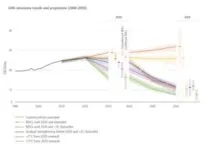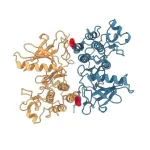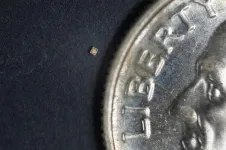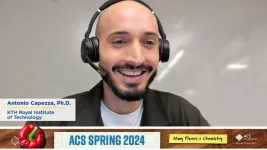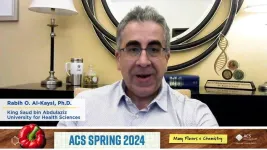(Press-News.org) The U.S. Department of Energy’s Princeton Plasma Physics Laboratory (PPPL) made a strong showing in this year’s Early Career Collection from the scientific journal Physics of Plasmas. The collection represents the top papers from all areas of plasma physics research authored by people who defended their dissertations less than five years before the journal article was submitted.
“The first authors of the pieces in the 2023 Early Career Collection have made a notable contribution to the field of plasma and show significant promise. I look forward to reading more of their work in the future,” said Igor Kaganovich, principal research physicist at PPPL and senior associate editor at Physics of Plasmas.
PPPL’s important work seeding the field of plasma physics was evident from the list of first authors, which included the following four people from the Lab:
Ben Israeli for his paper “Resonant Instabilities Mediated by Drag and Electrostatic Interactions in Laboratory and Astrophysical Dusty Plasmas.”
Stephen Majeski for his paper “Super-Fermi Acceleration in Multiscale MHD Reconnection.”
Ian Ochs for his papers “Ponderomotive Recoil for Electromagnetic Waves” and “Confinement Time and Ambipolar Potential in a Relativistic Mirror-confined Plasma.”
Willca Villafana for his paper “3D Particle-in-Cell Study of the Electron Drift Instability in a Hall Thruster Using Unstructured Grids.”
“It was a great surprise to be included,” said Villafana. “This kind of recognition from the community encourages you to do more good work.”
Israeli noted it is often more difficult for early career researchers to disseminate their ideas, as their networks are often smaller. “Highlighting the work of early career researchers helps to balance this,” he said.
Majeski, who will defend his dissertation next spring, said a collection like this one is important in the world of physics because it helps younger scientists promote their work. “Research benefits a lot from momentum, which can be hard to build. Opportunities like this early on can really help get something started,” he said. “It encourages others in the field to take a closer look at ideas or work they may not have considered before.”
Ochs offered advice to newcomers to the field of plasma physics. “People often come to plasma physics for the dream of harnessing nuclear fusion energy, and then become embroiled in a love-hate relationship with a discipline that contains both models of great mathematical beauty and a billion details, which mess up each of those models,” he explained. “I would advise people starting out to remember why they came to the field, to choose a mentor they trust and work well with, to choose projects they find both interesting and useful and to try to avoid rabbit holes while not being afraid to explore side applications and systems that arise naturally in the course of their research.” Finally, Ochs said not to get discouraged if a project does not yield fantastic results. “The frontier of knowledge is unpredictable.”
Haomin Sun, formerly of PPPL, was also included in the collection, as well as Nakul Nuwal, who collaborated with PPPL through the Princeton Collaborative Low Temperature Plasma Research Facility.
Physics of Plasmas editorial board members determine which pieces will be included in the Early Career Collection. The collection was first published in 2022.
PPPL is mastering the art of using plasma — the fourth state of matter — to solve some of the world's toughest science and technology challenges. Nestled on Princeton University’s Forrestal Campus in Plainsboro, New Jersey, our research ignites innovation in a range of applications including fusion energy, nanoscale fabrication, quantum materials and devices, and sustainability science. The University manages the Laboratory for the U.S. Department of Energy’s Office of Science, which is the nation’s single largest supporter of basic research in the physical sciences. Feel the heat at https://energy.gov/science and https://www.pppl.gov.
END
Four PPPL researchers featured in the Physics of Plasmas Early Career Collection
The collection highlights top scientific papers published in 2023 from across the field
2024-03-19
ELSE PRESS RELEASES FROM THIS DATE:
Does AI help or hurt human radiologists’ performance? It depends on the doctor
2024-03-19
One of the most touted promises of medical artificial intelligence tools is their ability to augment human clinicians’ performance by helping them interpret images such as X-rays and CT scans with greater precision to make more accurate diagnoses.
But the benefits of using AI tools on image interpretation appear to vary from clinician to clinician, according to new research led by investigators at Harvard Medical School, working with colleagues at MIT and Stanford.
The study findings suggest that individual clinician differences shape the interaction between human ...
Scientists identify Achilles heel of lung cancer protein
2024-03-19
Researchers have shown for the first time that a crucial interface in a protein that drives cancer growth could act as a target for more effective treatments.
The study was led by the Science and Technology Facilities Council (STFC) Central Laser Facility (CLF) and used advanced laser imaging techniques to identify structural details of a mutated protein which help it to evade drugs that target it.
It is published (19/03/2024) in the journal, Nature Communications and lays the groundwork for future research into ...
Insulin affects the recycling of cellular power plants
2024-03-19
The hormone insulin controls many cellular processes and adapts them to the body’s current energy supply. One of the insulin-regulated processes is the quality control of cellular power plants in neurons, Angelika Harbauer and her team at the Max Planck Institute for Biological Intelligence discovered. When sufficient energy is available in the body, insulin facilitates the elimination of defective mitochondria. When energy is scarce or when the insulin signal is interrupted, mitochondrial recycling is reduced and cells continue to use their old power plants, even potentially damaged ones. The continued operation of faulty mitochondria could affect ageing ...
Brown researchers develop brain-inspired wireless system to gather data from salt-sized sensors
2024-03-19
PROVIDENCE, R.I. [Brown University] — Tiny chips may equal a big breakthrough for a team of scientists led by Brown University engineers.
Writing in Nature Electronics, the research team describes a novel approach for a wireless communication network that can efficiently transmit, receive and decode data from thousands of microelectronic chips that are each no larger than a grain of salt.
The sensor network is designed so the chips can be implanted into the body or integrated into wearable devices. Each submillimeter-sized silicon sensor mimics ...
New research highlights strong demand for data on personalized risk of preeclampsia
2024-03-19
South San Francisco, Calif. (March 19, 2024) - A new study in BMC Pregnancy and Childbirth finds that objective information about risk of preeclampsia could be key to driving patient behavior change and creates motivation among pregnant patients to follow provider recommendations on prevention, even among those who are medication-hesitant.
Key findings include:
91% of the study participants desired predictive testing for preeclampsia
94% reported they would want blood pressure monitoring at home if found to be at high risk
88% reported they would be more motivated to follow their provider’s medication recommendations if at high risk. This finding was consistent ...
Toxic metal particles can be present in cannabis vapes even before the first use
2024-03-19
NEW ORLEANS, March 19, 2024 — Vapes have often been heralded as a “safer” way to consume either nicotine or cannabis, where legal to do so. But the devices present their own suite of risks that are slowly being revealed as they undergo increasing research and regulation. Now, researchers have discovered that nano-sized toxic metal particles may be present in cannabis vaping liquids even before the vaping device is heated, and the effect is worse in unregulated products.
The researchers will present their results today at the spring meeting of the American Chemical Society (ACS). ACS Spring 2024 is a hybrid meeting being held virtually and in person March ...
Is food waste the key to sustainable, plastic-free diapers and sanitary pads?
2024-03-19
NEW ORLEANS, March 19, 2024 — Once thrown away, disposable items such as diapers and sanitary pads can take hundreds of years to decompose, because their absorbent parts and waterproof layers contain plastics and other synthetic polymers. But now, researchers are replacing these materials with porous components made from protein biomass that is often discarded by the food and agricultural industries. These components are sustainable and biodegradable, and could potentially allow future diapers and sanitary pads to be flushed down a toilet or used as ...
Molecular crystal motors move like microbes when exposed to light
2024-03-19
NEW ORLEANS, March 19, 2024 — At first glance, Rabih O. Al-Kaysi’s molecular motors look like the microscopic worms you’d see in a drop of pond water. But these wriggling ribbons are not alive; they’re devices made from crystallized molecules that perform coordinated movements when exposed to light. With continued development, Al-Kaysi and colleagues say, their tiny machines could be used by physicians as drug-delivery robots or engineered into arrays that direct the flow of water around submarines.
The ...
Conversations in an MR scanner provides a novel view of the brain’s language network
2024-03-19
Researchers have revealed new insights into how the brain processes speech and listening during conversations through advanced investigations using functional magnetic resonance imaging (fMRI). In a groundbreaking study published in the esteemed journal Cerebral Cortex, researchers compared brain activity in individuals while both speaking and listening during natural conversational situations.
Conversational interactions are central to the everyday human experience. During conversation, we use language, together with social, and other cognitive skills to flexibly switch between the roles of speaker and listener. In research on ...
When words make you sick
2024-03-19
In a new book, experts in a variety of fields explore nocebo effects – how negative expectations concerning health can make a person sick. It is the first time a book has been written on this subject.
“I think it’s the idea that words really matter. It’s fascinating that how we communicate can affect the outcome. Communication in health care is perhaps more important than the patient recognises,” says Charlotte Blease, who is a researcher at the Department of Women’s and Children’s Health ...
LAST 30 PRESS RELEASES:
Injectable breast ‘implant’ offers alternative to traditional surgeries
Neuroscientists devise formulas to measure multilingualism
New prostate cancer trial seeks to reduce toxicity without sacrificing efficacy
Geometry shapes life
A CRISPR screen reveals many previously unrecognized genes required for brain development and a new neurodevelopmental disorder
Hot flush treatment has anti-breast cancer activity, study finds
Securing AI systems against growing cybersecurity threats
Longest observation of an active solar region
Why nail-biting, procrastination and other self-sabotaging behaviors are rooted in survival instincts
Regional variations in mechanical properties of porcine leptomeninges
Artificial empathy in therapy and healthcare: advancements in interpersonal interaction technologies
Why some brains switch gears more efficiently than others
UVA’s Jundong Li wins ICDM’S 2025 Tao Li Award for data mining, machine learning
UVA’s low-power, high-performance computer power player Mircea Stan earns National Academy of Inventors fellowship
Not playing by the rules: USU researcher explores filamentous algae dynamics in rivers
Do our body clocks influence our risk of dementia?
Anthropologists offer new evidence of bipedalism in long-debated fossil discovery
Safer receipt paper from wood
Dosage-sensitive genes suggest no whole-genome duplications in ancestral angiosperm
First ancient human herpesvirus genomes document their deep history with humans
Why Some Bacteria Survive Antibiotics and How to Stop Them - New study reveals that bacteria can survive antibiotic treatment through two fundamentally different “shutdown modes”
UCLA study links scar healing to dangerous placenta condition
CHANGE-seq-BE finds off-target changes in the genome from base editors
The Journal of Nuclear Medicine Ahead-of-Print Tip Sheet: January 2, 2026
Delayed or absent first dose of measles, mumps, and rubella vaccination
Trends in US preterm birth rates by household income and race and ethnicity
Study identifies potential biomarker linked to progression and brain inflammation in multiple sclerosis
Many mothers in Norway do not show up for postnatal check-ups
Researchers want to find out why quick clay is so unstable
Superradiant spins show teamwork at the quantum scale
[Press-News.org] Four PPPL researchers featured in the Physics of Plasmas Early Career CollectionThe collection highlights top scientific papers published in 2023 from across the field


